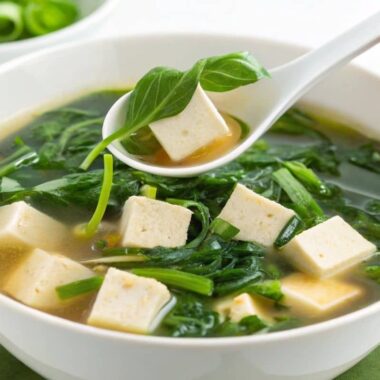What Part of Water Spinach Is Edible? Ever wondered what makes water spinach so special? 🌱 This leafy green, also known as “morning glory” or “kangkong,” is a popular ingredient in many Asian cuisines. But here’s the million-dollar question: What part of water spinach is edible? Spoiler alert—almost every part! Let’s dive into this guide to learn about its edible treasures, its health benefits, and the common challenges you might face while preparing it.
Table of Contents
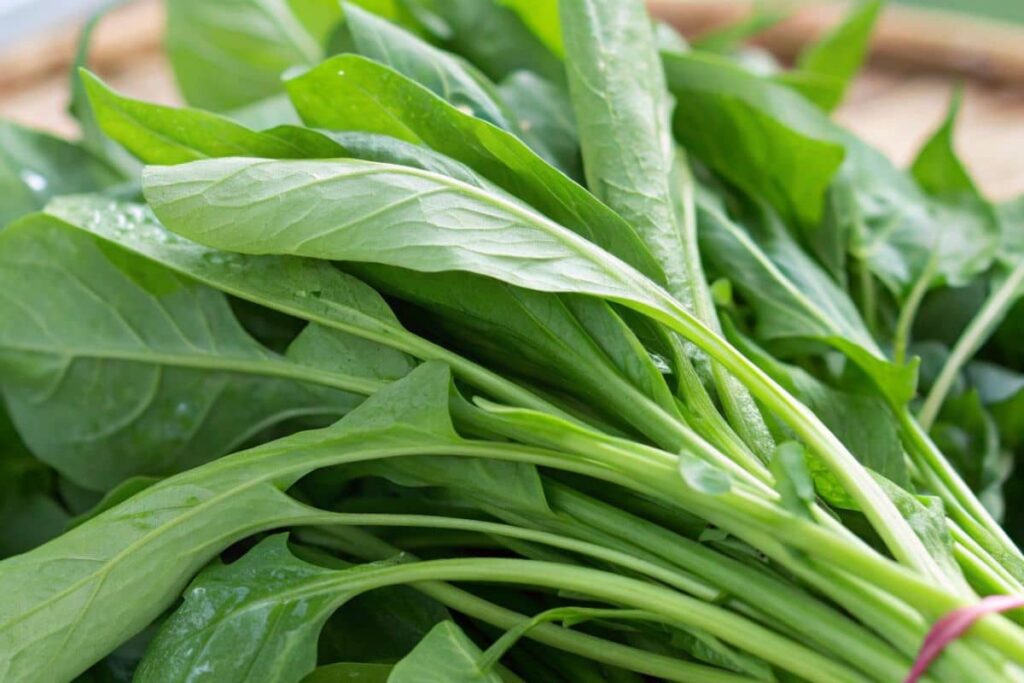
Water Spinach: The Green Wonder
Water spinach is more than just another green vegetable. Native to tropical and subtropical regions, it thrives in wetlands, riversides, and even ditches! 🌾 It’s a low-maintenance crop, making it a staple for many farmers. With its tender stems, lush leaves, and occasional flowers, water spinach is versatile, nutritious, and downright delicious. But why stop at calling it healthy when we can explore how each part of this plant adds value to our plates?
“Water spinach isn’t just a vegetable—it’s a powerhouse of flavor, nutrition, and creativity in the kitchen!”
Understanding Water Spinach Anatomy: What Part of Water Spinach Is Edible?
Before we jump into cooking, let’s break down what part of water spinach is edible. This fascinating plant is a culinary marvel, with each part offering unique characteristics and uses:
Stems: The Crunchy and Versatile Part
The stems of water spinach are like nature’s straws—they’re hollow, crunchy, and incredibly satisfying to eat. They soak up flavors like a sponge, making them perfect for stir-fries and soups. Plus, their texture is a delightful balance between crisp and tender.
Leaves: The Nutrient-Rich Powerhouse
The leaves are tender and slightly sweet, loaded with vitamins A, C, and iron. They’re great for sautéing, tossing into soups, or even blending into smoothies for an extra nutritional punch. Who knew leaves could be so versatile? 🌿
Flowers: An Underrated Edible Delight
Wait, flowers? Yep, you read that right! 🌸 The occasional flowers that appear on water spinach are edible too. They add a subtle, earthy flavor and a touch of elegance to salads and garnishes.
Roots: Can They Be Eaten Too?
While the roots are technically edible, they’re not as commonly used due to their tougher texture. However, in some traditional cuisines, even the roots find their way into broths and stews for added flavor.
Health Benefits of Water Spinach
Now that we know what part of water spinach is edible, let’s talk about why you should eat them! Water spinach isn’t just delicious—it’s a nutritional goldmine. Here’s why:
Packed With Essential Nutrients
Water spinach is brimming with vitamins and minerals. Think of it as a multivitamin in plant form. 🌟 It’s especially rich in vitamin A for your eyes, vitamin C for your immunity, and iron for your blood. Check out the nutritional breakdown below:
| Nutrient | Quantity (per 100g) |
|---|---|
| Calories | 19 |
| Vitamin A | 6300 IU |
| Vitamin C | 55 mg |
| Iron | 1.7 mg |
| Calcium | 77 mg |
Great for Digestion and Detoxification
Feeling bloated or sluggish? Water spinach to the rescue! Its high fiber content helps keep your digestive system on track. Plus, it’s great for detoxifying your liver and flushing out toxins.
A Natural Source of Antioxidants
Antioxidants are like little superheroes that protect your cells from damage. 🦸♀️ Water spinach is packed with them, helping to fight inflammation and keep you feeling young and healthy.
Culinary Uses of Water Spinach: What Part of Water Spinach Is Edible?
So, how do you get this green gem onto your plate? The options are endless! Knowing what part of water spinach is edible opens up a world of culinary possibilities. From stir-fries to soups, water spinach adapts to almost any recipe. Let’s explore:
Popular Dishes Featuring Water Spinach
Water spinach is a star in many Asian dishes. Have you tried Filipino Adobong Kangkong or Malaysian Belacan Kangkong? These dishes highlight its flavor beautifully, combining it with garlic, chili, and savory sauces. 🤤 Each dish celebrates what part of water spinach is edible, from its tender leaves to its crunchy stems.
Stir-Frying Water Spinach for Maximum Flavor
Stir-frying is one of the quickest and tastiest ways to prepare water spinach. Simply toss it with garlic, soy sauce, and a touch of chili for a side dish that pairs with almost anything. Pro tip: Cook the stems first before adding the leaves to avoid overcooking. This method ensures you’re using what part of water spinach is edible to its fullest potential!
Creative Soups and Salads with Water Spinach
Why limit yourself to stir-fries? Add water spinach to soups for extra nutrients or toss it raw into salads for a crunchy twist. 🥗 Understanding what part of water spinach is edible lets you get creative with your meals, transforming this humble green into a true game-changer for everyday dishes!
Common Problems When Preparing Water Spinach: What Part of Water Spinach Is Edible?
As amazing as water spinach is, preparing it can sometimes feel like a chore. But don’t worry—I’ve got your back! Knowing what part of water spinach is edible helps you tackle some of the common issues and find simple solutions. 🛠️
Removing Tough Fibers in the Stems
Ever bitten into a piece of water spinach stem only to find it tough and stringy? That’s because the stems can have fibrous outer layers, especially when they’re older. If you’ve ever had celery that didn’t want to be chewed, you know the struggle. The solution? Use a knife to peel the tough outer layer of the stems before cooking. It’s a bit of extra work, but trust me, it’s worth it for that perfect crunch. 🥢
Dealing with Muddy or Dirty Leaves
Water spinach is often grown in wetlands, so it’s no surprise that it can come with a fair bit of dirt. Nobody wants grit in their meal, right? To clean it, fill a large bowl with water, add a pinch of salt, and soak the water spinach for a few minutes. Swish it around gently, rinse thoroughly, and repeat if needed. Your greens will be sparkling clean and ready to cook! ✨
Preserving Freshness During Storage
Water spinach has a habit of wilting quickly if not stored properly. To keep it fresh, wrap the stems in a damp paper towel and store them in the vegetable crisper of your fridge. Knowing what part of water spinach is edible means you can maximize its use before it goes bad. 🥬
Solutions to Water Spinach Preparation Issues
Tips for Washing Water Spinach Thoroughly
When washing water spinach, think of it as giving your greens a mini spa day. 💦 First, trim off the roots and discard any yellow or damaged leaves. Soak the greens in cold water to loosen dirt, then rinse them under running water while gently rubbing the leaves and stems. For extra-clean greens, repeat the process a couple of times. This ensures every edible part of your water spinach is clean and ready to enjoy.
How to Trim and Cut Stems Efficiently
Not sure how to deal with those long stems? Here’s a tip: Use a sharp knife or kitchen scissors to cut the stems into 2- to 3-inch pieces. This size is perfect for stir-fries and soups, and it makes the cooking process a breeze. Remember to keep the leafy tops separate since they cook faster than the stems. By understanding what part of water spinach is edible, you can prepare it effortlessly!
Best Practices for Storing Water Spinach
If you’re not using your water spinach right away, don’t just toss it in the fridge. As mentioned earlier, wrapping the stems in a damp paper towel and placing them in a resealable bag works wonders. Another trick? Place the stems in a jar of water like a bouquet of flowers and store it in the fridge. It keeps the greens fresh for longer and ensures that every edible part stays crisp and ready for use.
Regional Variations in Water Spinach Preparation
Water spinach isn’t just a culinary favorite in one region—it’s beloved worldwide. Each culture has its unique twist on preparing this green wonder. 🌏
How Different Cultures Use Water Spinach
In Southeast Asia, water spinach is often stir-fried with garlic and chilies, creating bold and spicy dishes. Meanwhile, in China, it’s commonly paired with fermented tofu for a savory, umami-rich side dish. And in India, water spinach is a popular ingredient in vegetarian curries and lentil soups. Isn’t it fascinating how one plant can inspire so many culinary traditions?
Unique Cooking Techniques Around the World
While stir-frying is the most common method, other techniques include steaming, boiling, and even grilling water spinach. Yes, grilling! Imagine smoky, charred stems and leaves served with a zesty dipping sauce. 🤤 Some cultures even pickle water spinach stems for a tangy snack!
Can Water Spinach Be Eaten Raw?
Ah, the raw food debate. Can you munch on water spinach straight from the garden? The answer is yes—but with a few caveats.
Safety Concerns When Eating Raw Water Spinach
Raw water spinach can sometimes carry bacteria or parasites, especially if it’s grown in untreated water. To be safe, always wash it thoroughly before eating. If you’re unsure about its source, it’s better to cook it. Heat kills any unwanted guests and brings out its best flavors. 🔥
Nutritional Comparison: Raw vs. Cooked
Eating water spinach raw retains its full vitamin C content, but cooking enhances its antioxidant properties. It’s a win-win situation—choose what suits your meal and taste buds best!
Delicious Ways to Enjoy Water Spinach: Grilled Stems & a Refreshing Smoothie 🌿
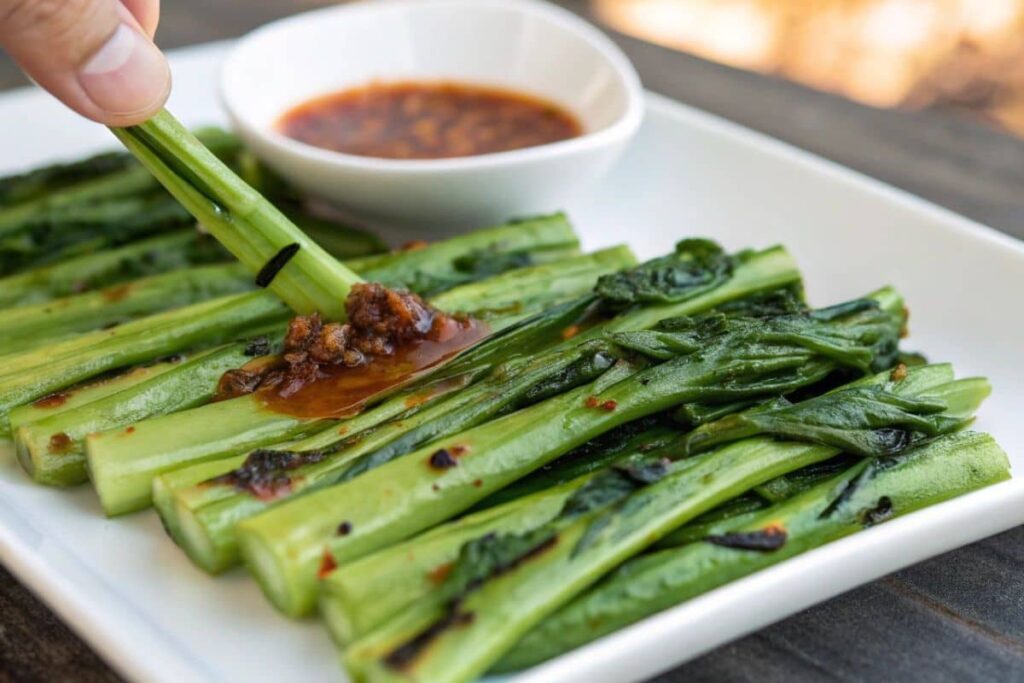
Grilled Water Spinach Stems with Spicy Dip
Ingredients
| Ingredient | Quantity |
|---|---|
| Water spinach stems | 200g (trimmed) |
| Olive oil | 2 tbsp |
| Salt | 1/2 tsp |
| Black pepper | 1/4 tsp |
| Garlic powder | 1/4 tsp |
| Chili sauce | 3 tbsp |
| Lime juice | 1 tbsp |
Instructions
- Prepare the stems: Trim the water spinach stems into 4-5 inch lengths, removing any tough outer fibers. Rinse thoroughly.
- Season the stems: Toss the stems in olive oil, salt, black pepper, and garlic powder to coat them evenly.
- Grill the stems: Preheat a grill pan or outdoor grill to medium heat. Place the seasoned stems on the grill and cook for 3-4 minutes on each side until lightly charred and tender.
- Prepare the dip: In a small bowl, mix chili sauce and lime juice. Adjust spiciness to your taste.
- Serve and enjoy: Arrange the grilled stems on a white plate with the spicy dip on the side. Serve warm and enjoy the smoky flavors!
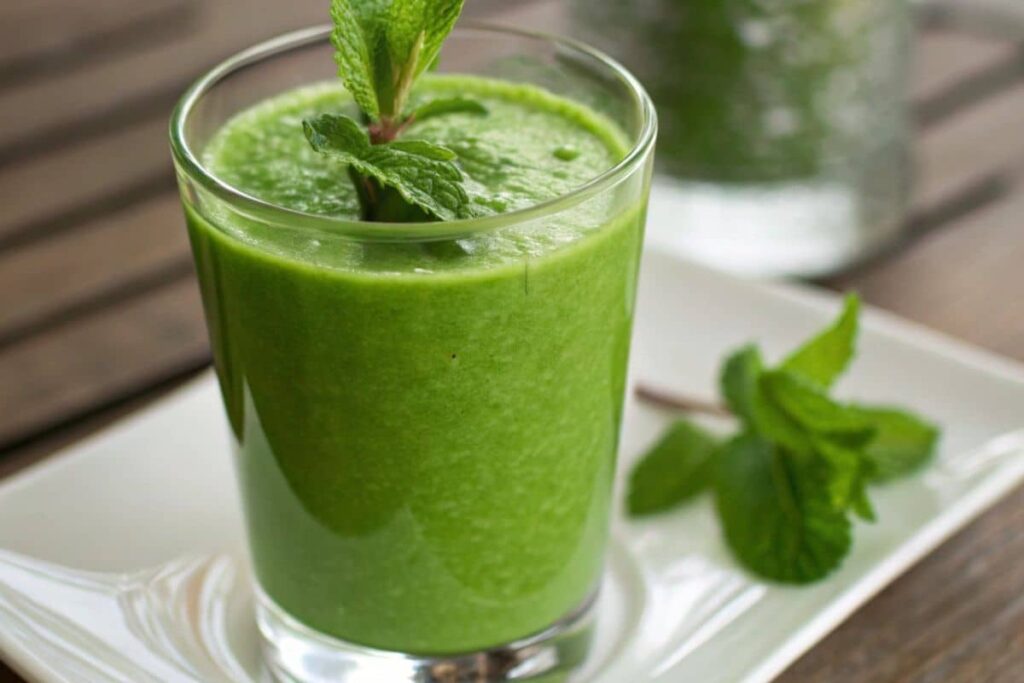
Refreshing Water Spinach Smoothie
Ingredients
| Ingredient | Quantity |
|---|---|
| Fresh water spinach leaves | 1 cup |
| Ripe banana | 1 medium |
| Pineapple chunks (fresh or frozen) | 1/2 cup |
| Coconut water | 1 cup |
| Lime juice | 1 tsp |
| Honey (optional) | 1 tsp |
| Mint leaves (for garnish) | A few sprigs |
Instructions
- Prepare the ingredients: Rinse the water spinach leaves thoroughly. Peel and chop the banana, and prepare the pineapple chunks.
- Blend it up: In a blender, add the water spinach leaves, banana, pineapple chunks, coconut water, lime juice, and honey (if desired). Blend until smooth and creamy.
- Taste and adjust: Taste the smoothie and adjust the sweetness with more honey if needed. Add more coconut water for a thinner consistency.
- Serve and garnish: Pour the smoothie into a glass and garnish with fresh mint leaves. Serve on a white plate for a refreshing presentation.
- Enjoy: Sip on this vibrant, nutrient-packed smoothie for a healthy energy boost! 🌿
Is Any Part of Water Spinach Toxic?
This might surprise you, but no part of water spinach is inherently toxic. However, as mentioned earlier, it’s essential to ensure it’s free from contaminants.
Understanding Potential Risks
The main risk lies in improper cleaning or sourcing. Water spinach grown in polluted water may absorb harmful substances, so always choose organic or reputable sources. Better safe than sorry, right?
How to Safely Consume Water Spinach
The golden rule: Wash, cook, enjoy. Whether you’re stir-frying, steaming, or tossing it into a salad, clean your greens properly to savor their natural goodness without worry. 🍴
Fun Facts About Water Spinach
Let’s lighten things up with some fun facts about this superstar veggie:
Historical Significance of Water Spinach
Did you know that water spinach has been cultivated for centuries? It was a staple crop in ancient Asian agriculture and even mentioned in Chinese medical texts for its health benefits. Talk about a veggie with a legacy!
Why It’s Called “Morning Glory” in Some Places
The nickname “morning glory” comes from its fast growth and vibrant flowers, which open in the morning. Just like you after a good breakfast, water spinach is ready to shine with the sunrise. 🌞
Conclusion: Why Water Spinach Deserves a Place in Your Diet
Water spinach isn’t just another green—it’s a culinary and nutritional gem. From its edible stems and leaves to its countless health benefits, this humble plant deserves a spot on your plate. So, next time you’re at the market, grab a bunch of water spinach and give these tips a try. Who knows? It might just become your new favorite veggie. 🥬
“When in doubt, water spinach it out!”
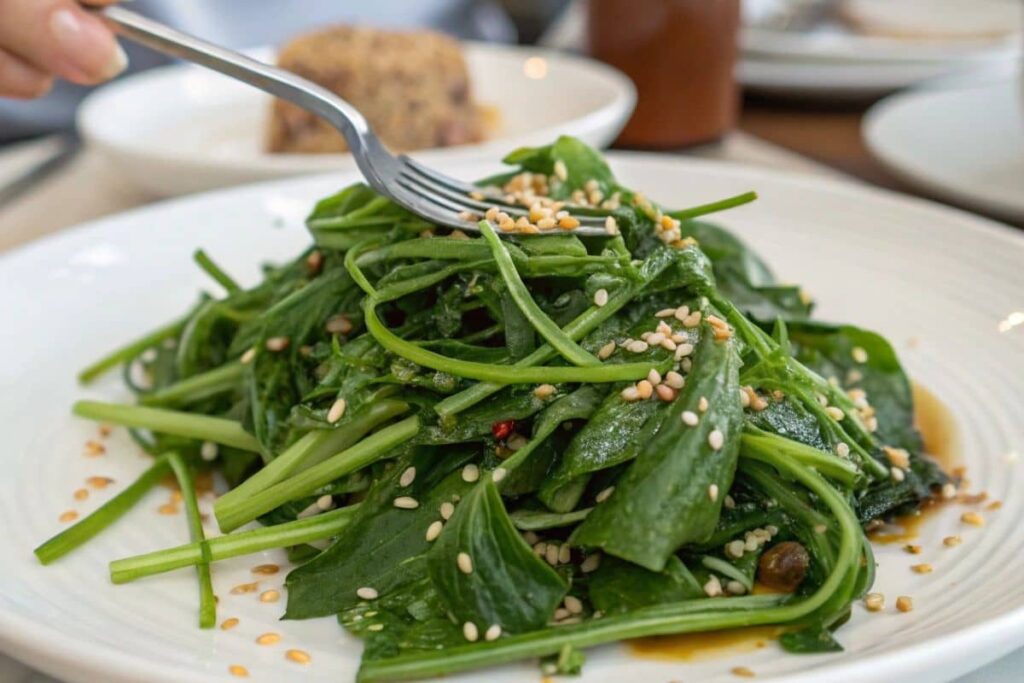
FAQ: Everything You Need to Know About Water Spinach
Got questions about water spinach? Don’t worry—we’ve got the answers! Let’s clear up some common doubts and help you make the most of this amazing plant. 🌿
Is Water Spinach the Same as Morning Glory?
Yes! Water spinach is often referred to as “morning glory” because of its fast-growing vines and morning-blooming flowers. If you’d like to learn more about this plant, visit our main page on Water Spinach for more details about its history, uses, and benefits.
Can I Grow Water Spinach at Home?
Absolutely! Water spinach thrives in warm, wet conditions, making it perfect for backyard gardens or even containers. With the right care and seeds, you’ll be harvesting your own water spinach in just a few weeks.
Does Water Spinach Need to Be Cooked?
Not necessarily! While cooking brings out its full flavors, water spinach can also be eaten raw in salads or smoothies. Just make sure to wash it thoroughly, especially if it’s not from a trusted source. Safety first, flavor second!
“Water spinach is the gift that keeps on giving—whether you’re cooking it, growing it, or learning about it!”
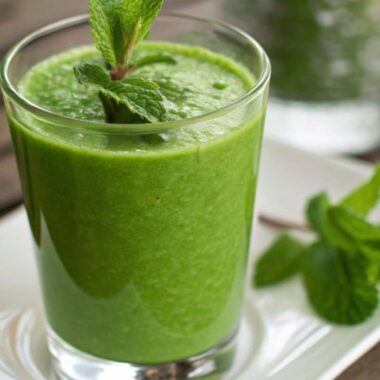
Water Spinach Recipes
Ingredients
Grilled Water Spinach Stems
- 200 g Water spinach stems (trimmed) Ensure they are trimmed and cleaned
- 2 tbsp Olive oil
- 1/2 tsp Salt
- 1/4 tsp Black pepper
- 1/4 tsp Garlic powder
- 3 tbsp Chili sauce Adjust according to taste
- 1 tbsp Lime juice
Refreshing Water Spinach Smoothie
- 1 cup Fresh water spinach leaves Rinsed thoroughly
- 1 medium Ripe banana Peeled and chopped
- 1/2 cup Pineapple chunks (fresh or frozen)
- 1 cup Coconut water
- 1 tsp Lime juice
- 1 tsp Honey (optional) Adjust sweetness if desired
- A few sprigs Mint leaves (for garnish)
Instructions
Grilled Water Spinach Stems
- Prepare the stems: Trim the water spinach stems into 4-5 inch lengths, removing any tough outer fibers. Rinse thoroughly.
- Season the stems: Toss the stems in olive oil, salt, black pepper, and garlic powder to coat them evenly.
- Grill the stems: Preheat a grill pan or outdoor grill to medium heat. Place the seasoned stems on the grill and cook for 3-4 minutes on each side until lightly charred and tender.
- Prepare the dip: In a small bowl, mix chili sauce and lime juice. Adjust spiciness to your taste.
- Serve and enjoy: Arrange the grilled stems on a white plate with the spicy dip on the side. Serve warm.
Refreshing Water Spinach Smoothie
- Prepare the ingredients: Rinse the water spinach leaves thoroughly. Peel and chop the banana, and prepare the pineapple chunks.
- Blend it up: In a blender, add the water spinach leaves, banana, pineapple chunks, coconut water, lime juice, and honey (if desired). Blend until smooth and creamy.
- Taste and adjust: Taste the smoothie and adjust the sweetness with more honey if needed. Add more coconut water for a thinner consistency.
- Serve and garnish: Pour the smoothie into a glass and garnish with fresh mint leaves.
- Enjoy: Sip on this vibrant, nutrient-packed smoothie for a healthy energy boost!

